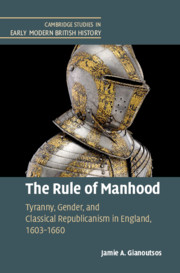Book contents
- The Rule of Manhood
- Cambridge Studies in Early Modern British History
- The Rule of Manhood
- Copyright page
- Dedication
- Contents
- Figures
- Acknowledgements
- Introduction
- Part I Emasculated Kingship
- Part II The Masculine Republic
- Chapter 5 John Milton, Marriage, and the Realisation of Republican Manhood
- Chapter 6 ‘Begin now to know themselves men, & to breath after liberty’
- Chapter 7 ‘So much power and piety in one’
- Conclusion
- Bibliography
- Index
Chapter 5 - John Milton, Marriage, and the Realisation of Republican Manhood
from Part II - The Masculine Republic
Published online by Cambridge University Press: 26 January 2021
- The Rule of Manhood
- Cambridge Studies in Early Modern British History
- The Rule of Manhood
- Copyright page
- Dedication
- Contents
- Figures
- Acknowledgements
- Introduction
- Part I Emasculated Kingship
- Part II The Masculine Republic
- Chapter 5 John Milton, Marriage, and the Realisation of Republican Manhood
- Chapter 6 ‘Begin now to know themselves men, & to breath after liberty’
- Chapter 7 ‘So much power and piety in one’
- Conclusion
- Bibliography
- Index
Summary
When John Milton’s Samson bemoans his fate in Samson Agonistes (c. 1671), he cries against his marriage with Dalila – his enslavement to an idolatrous woman – as even more degrading than the physical chains which bind him as a slave. ‘True slavery’, he claims, was that which he had suffered through ‘degenerat’ and ‘misyoked’ marriage to a heathen; his passivity and inability to escape such bondage, due to his untamed lust, had proven him incapable of exercising the manly attributes of rationality, temperance, and civic virtue necessary to remain free. Indeed, in Samson Agonistes, Milton’s Samson regains a Stoic posture only through accepting his physical chains and seeking sacrificial death as a just ransom for his own masculine and moral failings.
- Type
- Chapter
- Information
- The Rule of ManhoodTyranny, Gender, and Classical Republicanism in England, 1603–1660, pp. 231 - 273Publisher: Cambridge University PressPrint publication year: 2020

